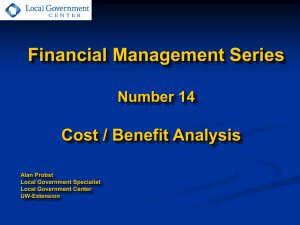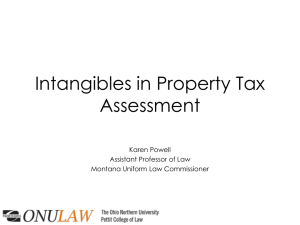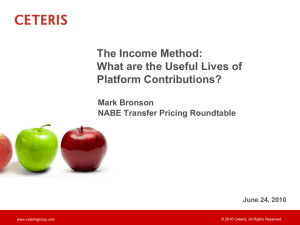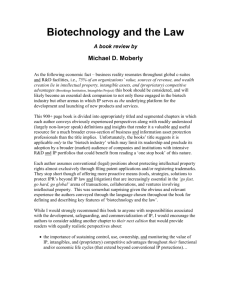Implications of Accounting Research for the FASB's Initiatives on Disclosure
advertisement
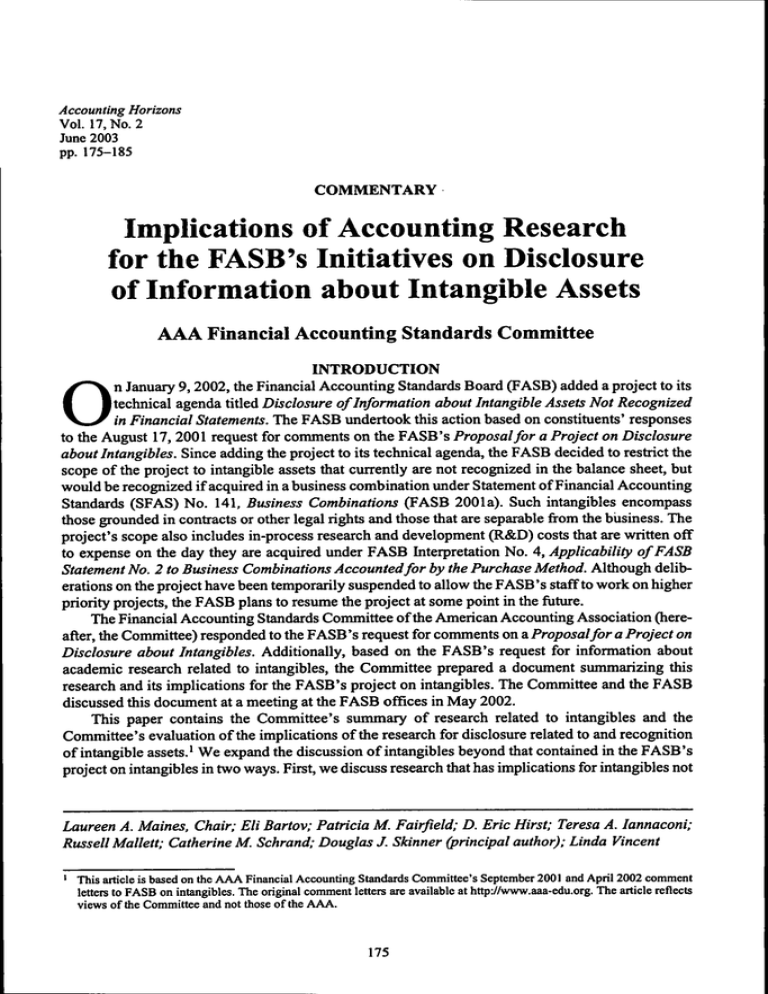
Accounting Horizons Vol. 17, No. 2 June 2003 pp. 175-185 COMMENTARY Implications of Accounting Research for the FASB's Initiatives on Disclosure of Information about Intangible Assets AAA Financial Accounting Standards Committee INTRODUCTION n January 9,2002, the Financial Accounting Standards Board (FASB) added a project to its technical agenda titled Disclosure of Information about Intangible Assets Not Recognized in Financial Statements. The FASB undertook this action based on constituents' responses to the August 17, 2001 request for comments on the FASB's Proposal for a Project on Disclosure about Intangibles. Since adding the project to its technical agenda, the FASB decided to restrict the scope of the project to intangible assets that currently are not recognized in the balance sheet, but would be recognized if acquired in a business combination under Statement of Financial Accounting Standards (SFAS) No. 141, Business Combinations (FASB 2001a). Such intangibles encompass those grounded in contracts or other legal rights and those that are separable from the business. The project's scope also includes in-process research and development (R&D) costs that are written off to expense on the day they are acquired under FASB Interpretation No. 4, Applicability of FASB Statement No. 2 to Business Combinations Accounted for by the Purchase Method. Although deliberations on the project have been temporarily suspended to allow the FASB's staff to work on higher priority projects, the FASB plans to resume the project at some point in the future. The Financial Accounting Standards Committee of the American Accounting Association (hereafter, the Committee) responded to the FASB's request for comments on a Proposalfor a Project on Disclosure about Intangibles. Additionally, based on the FASB's request for information about academic research related to intangibles, the Committee prepared a document summarizing this research and its implications for the FASB's project on intangibles. The Committee and the FASB discussed this document at a meeting at the FASB offices in May 2002. This paper contains the Committee's summary of research related to intangibles and the Committee's evaluation of the implications of the research for disclosure related to and recognition of intangible assets.' We expand the discussion of intangibles beyond that contained in the FASB's project on intangibles in two ways. First, we discuss research that has implications for intangibles not O Laureen A. Maines, Chair; Eli Bartov; Patricia M. Fairfield; D. Eric Hirst; Teresa A. Iannaconi; Russell Mallett; Catherine M. Schrand; Douglas J. Skinner (principal author); Linda Vincent ' This article is based on the AAA Financial Accounting Standards Committee's September 2001 and April 2002 comment letters to FASB on intangibles. The original comment letters are available at http://www.aaa-e<lu.org. The article reflects views of the Committee and not those of the AAA. 175 176 , AAA Financial Accounting Standards Committee included in the restricted scope of the FASB's project described above. Second, we examine implications of research for recognition of intangibles, in addition to implications for disclosure of information related to intangibles. RESEARCH RELATED TO INTANGIBLE ASSETS We categorize research on intangibles into three areas that we discuss in tum: (1) research related to current financial reporting for intangible assets, (2) research related to disclosures about intangible assets, and (3) research related to recognition of intangible assets. Most of this research is empirical-archival in nature and focuses on R&D-related intangibles. Overview of the Nature of Intangibles Research For pragmatic reasons, most research on intangibles focuses on those intangibles generated by R&D expenditures. Data on R&D spending are widely available because R&D expenditures must be disclosed separately under SFAS No. 2, Accountingfor Research and Development Costs. Because there is no such requirement for other types of intangibles expenditures. Lev (2001, 54-55) notes that empirical-archival research on intangibles is hindered. The focus on R&D raises the question of whether the results of this research generalize to other types of intangibles. It seems to us that the answer to this question depends on whether R&D assets are economically similar to other intangibles and on how familiar investors are with information about other types of intangibles. If the economic process involved in developing these other intangibles is different from that of R&D intangibles, it is not clear that evidence based on R&D has direct implications for other types of intangibles. For example, intangibles such as customer satisfaction and employee morale seem quite different from R&D. Additionally, because information about R&D expenditures has been disclosed for many years, investors likely are more familiar with firms' R&D activities than other types of intangibles potentially present in the firm. At a minimum, this suggests that there will be a learning curve in investors' use of information related to intangibles other than R&D. Research Related to Current Financial Reporting for Intangibles Has the Relevance of Financial Statement Information Declined through Time? Well-known commentators such as Robert Elliott, Steven Wallman, and Baruch Lev assert that intangibles play an increasingly important role in the economy. They argue that because fmancial statements do not adequately reflect information about these assets, relevance of these statements has declined through time. The large run-up in U.S. equity prices relative to book values and earnings during the 1990s, especially for technology firms, added fuel to this argument. Several papers address the question of whether financial statement information has become less relevant over time.^ Collins et al. (1997) and Francis and Schipper (1999) regress stock prices on financial statement measiu-es of eamings and book values to investigate whether the explanatory power of these variables for stock prices—^their "value relevance"—^has changed over time. The authors find little evidence that the overall value relevance of financial statements has declined through time, although both papers report some evidence that the balance sheet has increased in importance relative to the income statement. Both papers also find little support for the view that value relevance results differ for high-technology firms with potentially large intangibles compared to firms in other industries. As is the case throughout this report, we do not mean to imply the papers discussed represent a comprehensive list of papers in this area. Rather, our goal is to choose some representative papers to give the reader a sense for the broad methodological approaches and results in each area. Accounting Horizons, June 2003 Implications ofAccounting Research for the FASB's Initiatives on Disclosure Brown et al. (1999) and Chang (1999), however, raise questions about the inferences of these studies on statistical (econometric) grounds.^ After correcting the statistical problems, these authors conclude that there is a decline over time in the value relevance of financial statement information, such as earnings and book value. Core et al. (2003) examine the explanatory power and stability of a regression model of equity values on traditional financial variables over a 25-year period ending in 2000 to investigate whether equity valuation in the recent "New Economy" period differs from prior periods. The authors study the population of publicly traded firms and subsamples of high-technology firms, young firms, and young firms with losses. Core et al. (2003) find tfiat the explanatory power of tiiese regressions declines over time for all groups of firms, but that the basic structure of the model remains stable over the entire period. The authors find little evidence of a change in the fundamental determinants of equity values through time. Perhaps the best conclusion about research in this area is that the results are mixed, with no clear evidence of a decline in the value relevance of financial statement information over time, even for high-technology firms. Thus, there is no clear evidence supporting claims that traditional financial statements have become less relevant to investors over time. Is Information Currently Provided about Intangibles "Value Relevant" to Investors? The goal of the value relevance studies discussed below is to assess the extent to which a given intangibles measure is associated with stock prices. If a significant association exists, the measure is said to be "value relevant" to investors. Researchers typically regress market value of equity (or stock price) on the book values of balance sheet assets, liabilities, and intangibles measures assumed to be available to investors, often through footnote disclosures. Researchers draw inferences about the value relevance of the intangibles measure by assessing whether its coefficient is of the predicted sign and reliably different from zero. We now discuss some representative studies in this area. Lev and Sougiannis (1996) investigate the value relevance of pro forma book values and earnings of U.S. companies, adjusted to reflect estimates of capitalized and amortized R&D and advertising expenditures. They fmd that these adjustments are value relevant to investors. Barth et ai. (1998) use data on brand values published in Financial World, a financial magazine, to investigate the data's value relevance. They find that the coefficient on brand values is positive and statistically significant, although about half the size of the coefficient on recognized assets. One question about this study illustrates a general causality problem that can arise with studies in this area: does the disclosed information about brand values drive market prices, or do market prices drive firms' estimates of their brand values? Gu and Lev (2001) investigate the value relevance of firms' disclosures of their royalty income and fmd that the market assigns a larger coefficient to royalty income than to other components of earnings. This result may indicate that royalty income is more permanent than other elements of residual earnings. However, because the sample includes only firms that choose to disclose royalty income, it is difficult to assess whether the results are due to the royalty income disclosures themselves or factors associated with the firm's decision to disclose royalty income. Ittner and Larcker (1998) investigate the value relevance of customer satisfaction (CS) data, and find that while CS data are value relevant, the coefficients on CS data are much less significant than those on recognized assets. The authors' results vary a great deal across different industries and, as Lambert's (1998) discussion of the paper points out, the regression specifications omit an earnings measure. The value relevance results for CS data may simply proxy for the correlated, but omitted, Brown et al. (1999) argue that there are problems with comparing the explanatory power of regressions (R^s) through time principally because of changes in the scale factor of the regression's coefficient of variation. Accounting Horizons, June 2003 177 • 78 AAA Pinancial Accounting Standards Committee earnings measure. Lambert (1998) also points out that, similar to some other value relevance studies, the CS data were not actually available to investors on the dates that the authors measured share prices, increasing interpretational difficulties. Amir and Lev (1996) find that nonfinancial indicators of growth and a measure related to an unrecorded intangible asset (customers) are value relevant for firms in the cellular phone industry. These authors also document that traditional financial variables by themselves have little explanatory power for the value of these firms, but that their explanatory power increases when combined with the nonfinancial measures related to potential growth and intangibles. Aboody and Lev (1998) investigate the value relevance of software development costs for software firms. They report an association between capitalized software development costs and stock retums and stock prices but find that the coefficients on capitalized software costs are smaller than those on more conventional assets. Ely and Waymire (1999) assess the value relevance of intangibles recognized as assets using data firom 1927, one year in the "pre-SEC" era when firms were able to capitalize internally generated intangibles. They find that investors were skeptical of these capitalized intangible amounts and placed a smaller weight on capitalized intangibles than on tangible assets.^ To summarize, although value relevance studies find that information about intangibles is associated with equity prices and is value relevant to investors, the coefficients are often smaller than those on recognized assets. Holthausen and Watts (2001) point out, though, that results in this area may have limited implications for standard setting because the research relies on associations.* The research finds an association between certain information and stock prices, but provides little insight on the economic reasons for this association.^ Related problems in interpreting these studies involve "correlated omitted variables." Because we have no precise theory of how equity values map into balance sheet measurements of assets, liabilities, and the researcher's variable of interest, it is hard to ensure the regressions include all relevant explanatory variables. To take a simple example, suppose a reliable measure of the firm's growth prospects, known to be important for valuation, is not included in the regression. A significant coefficient on the intangibles variable may therefore refiect the omitted growth variable, especially since firms with relatively more off-balance-sheet intangibles are likely to have more growth opportunities than other firms. In other words, when correlated variables are omitted, researchers may find a significant coefficient on the intangibles variable even when investors do not use this information. The problem works in the other direction as well. When correlated omitted variables and the associated measurement error bias are present, the researcher may find statistically insignificant coefficients even when investors are using the information disclosed about the variable of interest (see Maddala 1977, Ch. 13). Value relevance studies also rely on equity prices being "correct" or "efficient," in that the market correctly assesses value, given the information available. To the extent that the market is not In his discussion of this paper, Zarowin (1999) states that at the time, finns could choose whether to capitalize and amortize intangibles or to write them off immediately against equity "surplus." He argues that financially strong finns preferred to take the write-off and explicitly chose to report intangibles at nominal amounts. Consequently, the study suffers fVom an important selection bias; the firms that capitalized intangibles signaled a lack offinancialstrength, which potentially explains the negative/zero coefficients on intangibles. Zarowin (1999) also questions how efficient the stock market was in the 1920s. Our discussion draws on points made in a steady stream of previous papers that discuss the limitations of value relevance research, especially in the context of standard setting, including Bernard and Schipper (1994), Holthausen and Palepu (1994), Lambert (1996), Skinner (1996, 1999), Ohlson (1998), and Holthausen and Watts (2001). For example, we do not know whether investors actually use the information contained in thefinancialstatements. In fact, some studies regress stock prices at December 31 of a year on financial statement data for the fiscal year ending on December 31. Financial statements are typically not available to investors until three or four months into the next year so it is hard to know how investors have access to the infomiation to whieh they are supposedly responding. Accounting Horizons, June 2003 Implications ofAccounting Research for the FASB's Initiatives on Disclosure 179 efficient in this manner, it is difficult to know what to make of correlations between equity valuations and the variables of interest.^ Finally, Holthausen and Watts (2001) emphasize that financial statements serve purposes other than as inputs to equity valuation. Therefore, it is not clear why an association with equity prices should be the primary benchmark for evaluating whether to disclose information about intangibles, or to recognize them in the balance sheet. For example, if lenders use the balance sheet as a means of assessing potential liquidation values, it is not clear that intangible assets such as customer loyalty and employee morale, which are likely to be worth considerably more when the entity is a going concem rather than in liquidation, should be recognized in financial statements.* To summarize, value relevance research finds that intangibles information is associated with stock prices, although in many cases not to the same extent as conventionally recognized assets. Therefore, although intangibles information likely is of some use to investors, methodological problems create a good deal of controversy in the profession about the extent to which this research has implications for standard setting. Does the Market Appropriately Assess the Implications of Current R&D Spending? Beginning with Lev and Sougiannis (1996), a number of studies find that stock retums are associated with the level of firm's R&O expenditures in periods after those expenditures are made and reported to investors (Chambers et al. 2002; Chan et al. 2001; Lev et al. 2002; Penman and Zhang 2002). This puzzling evidence suggests that because investors do not quickly and in an unbiased way assess the implications of current R&D spending for the future eamings potential of the firm, they systematically undervalue high R&D firms. As firms realize the benefits of these expenditures in subsequent eamings, the market corrects this undervaluation, leading to abnormal retum performance. An altemative interpretation of these results is that researchers in these studies systematically underestimate the risk of R&D firms, and that the observed apparent abnormal retums simply refiect the fact that R&D firms are more risky. Assuming this evidence can be interpreted as evidence of market inefficiency, it suggests that investors systematically underestimate the value of fums' R&D programs. Given that research has documented market underreactions to much more basic accounting numbers, such as quarterly eamings reports and the accruals component of eamings, it is not clear that the remedy for the market's underestimation of intangibles can or should emanate from the FASB.^ However, these results tell us something about whether investors fully understand the valuation implications of R&D spending.'" Do Managers Change Their Spending on R&D Depending on the Accounting Recognition Rule? Research on the "Economic Consequences" of SFAS No. 2 Several early studies use the 1974 FASB change in accounting for R&D costs to investigate the "economic consequences" of immediately expensing R&D costs. Dukes et al. (1980) examine whether companies reduce the level of R&D spending after SFAS No. 2 became effective, as one expects if the expensing treatment discourages R&D spending. However, Ball (1980) points out that evidence of reduced R&D spending is difficult to interpret because the results are confounded by selection biases and other economic changes that occur around the same time, such as the effects of the Arab oil embargo and recession. ^ In fact, as we discuss below, some studies document apparent inefficiencies with respect to the market's ability to correctly process information about R&D expenditures. ' The point that intangible assets often have much smaller values in the event of liquidations is clear fi'om recent events, including the collapse of Enron and several large firms in the telecom sector. See "The Rise and Fall of Intangible Assets," Wall Street Journal, April 4, 2002. ' See Bernard and Thomas (1990) and Sloan (1996), respectively. '" This evidence has implications for how we interpret the results of value relevance studies, which rely on market prices being correctly formed. Accounting Horizons, June 2003 180 AAA Financiat Accounting Standards Committee Another set of studies investigates whether managers' R&D spending is affected by financial reporting considerations. Baber et al. (1991) find that managers reduce R&D expenditures to meet prespecified earnings targets, but find no evidence of similar reductions in expenditures that can be capitalized. Bushee (1998) fmds that managers reduce R&D expenditures to meet short-term earnings targets, and that institutional ownership appears to reduce this tendency. Dechow and Sloan (1991) find evidence that managers tend to reduce their firms' R&D expenditures when they are close to retirement and their horizons are short so that they care less about the adverse long-run effects of such reductions. All of this evidence suggests tiiat SFAS No. 2 does have economic consequences. Research Related to Disclosures about Intangible Assets We have little direct evidence on the benefits and costs of intangibles disclosures. The fact that voluntary disclosures of intangibles information are not widespread suggests that the net private benefits that accrue to firms from these disclosures are relatively small." Costs associated with intangibles disclosures include costs of measuring intangibles and the proprietary costs associated with disclosing this information to competitors. Preparers frequently argue that the proprietary costs of intangibles disclosures outweigh the benefits of disclosure. This argument suggests that competitive and other economic costs of intangibles disclosures are relatively large, or that benefits of these disclosures are relatively small, due perhaps to low relevance or imprecise measurement. Whatever the case, it seems to us that the relatively low levels of voluntary disclosure in the intangibles area raise the possibility that managers are correct in stating that disclosures in this area do not provide net benefits to current shareholders. The nondisclosure of value relevant information creates "information asymmetries" between insiders such as management and extemal investors. Two recent studies report that the current accounting for R&D in the U.S. creates information asymmetries that adversely affect market liquidity. Aboody and Lev (2000) find larger gains from insider trading in R&D-intensive firms than for other firms, suggesting that insiders exploit their private information about the firm's R&D projects. Boone and Raman (2001) conclude that R&D-intensive firms have higher "adverse selection" components of the bid-ask spread, a common measure of liquidity, again consistent with these firms having less liquid markets for their firms' shares. These studies suggest that market liquidity will improve if there is more disclosure about these firms' R&D projects. In his discussion of Ittner and Larcker (1998), Lambert (1998) raises questions about the reliability and comparability of intangibles information. Ittner and Larcker (1998) examine the relation between customer satisfaction (CS) data and future values of perfonnance metrics such as revenues, expenses, margins, return on sales, and customer retention rates. Lambert (1998) points to two problems that will arise if such disclosures are mandated. First, Lambert (1998) argues that CS numbers are "softer" than most reported accounting measures and that measures for "soft" intangibles like CS are difficult to standardize. The surveys measuring these data use different questions, have different scales, employ different methods of aggregating the scores, use different polling methods, and so forth. Second, Lambert (1998) notes that a disclosure standard must provide guidance on how to measure and present customer satisfaction data and whether the data should be provided at the level of the firm or its geographic or business segments. We believe that these important questions pervade the general debate about disclosing intangibles and note that the Conceptual Framework provides little guidance about disclosure questions in general. " The relatively low level of voluntary disclosure in the intangibles area is doeumented in the recent Steering Committee Report of the Business Reporting Research Project, "Improving Business Reporting; Insights into Enhancing Voluntary Disclosures" (FASB 2001b). Accounting Horizons. June 2003 Implications ofAccounting Research for the FASB's Initiatives on Disclosure 181 Research Reiated to Recognition of Intangibie Assets Recognition and the Nature oflntangibte Assets Intangible "assets" such as intellectual capital and customer loyalty are conceptually different from assets normally recognized on the balance sheet.'^ These differences include: • Many intangibles like customer loyalty are not separate and salable assets—^their value can be measured only as part of the residual value of the firm. • The well-defined property rights of physical and financial assets that effectively define control and exclude others from enjoying the benefits of these assets often do not extend to intangibles. • There are few organized, liquid markets for most intangibles. • Due to the inseparability of intangible assets and the ill-defined property rights, it is often difficult to write complete contracts for intangible assets. These characteristics make it difficult for intangible assets to meet the normal asset recognition criteria. In addition, the balance sheet model implicit in many value relevance studies holds only if well-fiinctioning, competitive markets exist for the firm's assets and liabilities, so that these assets do not earn abnormal returns.'' Because these conditions generally do not apply to intangible assets, value relevance studies are especially difficult to interpret in this area. Lambert (1998) points out that there are also problems with choosing a measurement basis. When we use cost as the measurement basis, it is difficult to know which costs relate solely to the acquisition of intangibles, when all aspects of the firm's operations affect an intangible like customer satisfaction. Additionally, the portions of these costs that have future benefits are difficult to determine. Lambert (1998) also observes that, if fair value is to be the measurement basis, we are a "long way" from being able to value many intangibles, such as customer satisfaction, given the many industry and competitive forces that affect intangibles' values. Does Spending on Intangibtes Generate Future Benefits? Are These Benefits Reflected in Market Prices? One of the key empirical questions in research on intangibles is whether intangibles expenditures generate future revenues and earnings. Clear evidence of a link between current expenditures and future revenues and earnings will strengthen the argument in favor of recognizing intangibles. In perhaps the best-known and most carefully executed study in this area. Lev and Sougiannis (1996) first develop a model of the relation between a firm's earnings (output) and its investment inputs, including expenditures on R&D and advertising. The authors then estimate this model and report that: (1) the average duration of R&D benefits varies across industries from five to nine years, and (2) the estimated benefits of these R&D programs vary from $1.66 to $2.63 per dollar of R&D spending, and imply an intemal rate of return on R&D that varies from 15 percent to 28 percent. As stated earlier, the authors use these estimates to construct pro forma book values and earnings numbers adjusted to reflect the estimated effect of capitalizing and amortizing R&D expenditures. They report "substantial differences" between these pro forma numbers and those originally reported. Not too surprisingly, this implies that a policy of capitalizing and amortizing R&D expenditures, rather than immediate expensing, will have a material effect on firms' financial statements. Other papers report similar evidence. In their study of software development costs, Aboody and Lev (1998) report that the amount capitalized helps predict one- and two-year-ahead earnings changes, with a larger coefficient on capitalized costs than on costs that are expensed. Barth et al. (1998) report that brand values are correlated with future operating margins and market share. '2 See Lev (2001, Ch. 2) for a good discussion of the economic nature of intangible assets. This section draws on the discussion in Holthausen and Watts (2001, 36 and 52-53). " This is the likely reason some of the first value relevance studies were conducted to assess the value relevance of the fair value of marketable securities, an asset class for which these assumptions may hold, at least to a first approximation. Accounting Horizons, June 2003 182 AAA Financial Accounting Standards Committee These results are somewhat difificult to interpret without a well-specified theory that allows clear predictions about expected coefficient signs and magnitudes. One criticism of this research is that the observed positive relation between this period's expenditures and future periods' eamings is confounded by increases in the scale ofthe firm's investment base. '* That is, if the firms chosen for these studies were growing through time so that their asset bases were increasing, we naturally expect to observe increases in the level of future eamings even if intangibles expenditures were unproductive. Overall, the research finds that current period expenditures are associated, on average, with future period eamings although, as is the case with value relevance studies, there is some question about whether this relation is causal. Are the Benefits Associated with Intangibles Expenditures More Uncertain than Those Associated with Other Types of Expenditures? Research also examines the relative risk of investments in R&D projects. Kothari et al. (1998) compare the uncertainty of benefits associated with expenditures on R&D and capital equipment. They regress measures of future eamings variability that proxy for the uncertainty of future benefits on levels of current R&D spending and capital expenditures, as well as on control variables such as fimi size and leverage. Kothari et al. (1998) find that the coefficient on R&D is about three times as large as that on capital expenditures, and conclude that the future benefits of R&D spending are more uncertain and less reliable than those on capital equipment. They argue that the uncertain benefits of R&D expenditures help explain and justify the conservative accounting treatment of expensing R&D costs. Shi (2003) analyzes the relation between bond prices and various measures of R&D expenditures. He finds fairly consistent evidence that the relative amount of R&D spending undertaken by firms is positively associated with bond risk premia and default risk. This suggests that, on average, R&D spending increases the riskiness of bondholders' claims on the firm. But when one thinks of equities as call options on the value ofthe firm, increases in both the mean and variance ofthe retum on the firm's assets increase value. For debt, however, the mean effect is positive while the variance effect is negative. Thus, the value of bondholders' claims declines as the firm's assets get riskier. Shi's (2003) evidence indicates that, on average for bonds, the negative variance effect of R&D projects outweighs the positive mean effect, so that R&D projects reduce the value of bondholders' claims. He concludes that R&D projects are substantially riskier than other types of projects. To siunmarize, the studies described above find that, on average, R&D expenditures have future benefits and that these future benefits are more uncertain than those associated with conventionally recognized assets. This likely explains why, in value relevance studies, the coefficients on unrecognized intangible assets tend to be smaller than those on conventional recognized assets. The key question for standard setters is whether the benefits are sufficiently probable to justify recognizing estimated intangibles in the financial statements, a judgment that research alone cannot answer. Are Managers'Intangibtes Recognition Choices Affected by Their Incentives under Firm Contracts? One ofthe few attempts to study the determinants of managers' financial reporting choices for intangibles is Muller (1999). Using a set of firms in the United Kingdom (U.K.), Muller examines their managers' decisions regarding whether to recognize an asset for the value of brands acquired through acquisitions. At the time ofthe study in the U.K., the suggested method of accounting for purchased goodwill was to immediately write off the goodwill against equity. Altematively, managers could choose to capitalize part ofthe goodwill as a brand name intangible asset. Muller (1999) finds that two contracting explanations infiuence managers' goodwill decisions. First, London Stock Exchange rules require shareholder approval for acquisitions above a certain size threshold measured using reported book values. Muller (1999) finds that firms that are likely to '* See, for example, Sloan (1999). Accounting Horizons, June 2003 Implications ofAccounting Research for the FASB's Initiatives on Disclosure 183 bear the largest costs from this mle are less likely to capitalize brands, minimizing their stated book values and reducing the likelihood that shareholder approval is required for future acquisitions. Second, consistent with the conventional debt-equity argument in the literature that firms with higher leverage are likely to be closer to debt covenant constraints, Muller (1999) finds that firms with higher leverage are more likely to capitalize the value of brands, reducing book measures of leverage. As Sloan (1999) observes, Muller's (1999) results suggest that managers' recognition decisions are strongly influenced by contracting incentives, indicating that they exercise considerable discretion over such decisions. This is likely to compromise the reliability of managers' estimates ofthe value of intangibles. When combined with the extensive evidence indicating that managers' accounting choices are influenced by their firm's economic circumstances, especially incentives provided by the firm's contracts (Watts and Zimmerman 1986; Healy and Wahlen 1999), this result suggests that managers' reporting decisions with respect to intangibles are infiuenced by their incentives, compromising their reliability.'* CONCLUSIONS Overall, research suggests that investors use disclosures on intangibles expenditures and that intangibles expenditures have fiiture benefits, but that these benefits are more uncertain than those associated with conventionally recognized assets. Thus, there is some empirical support for the capitalization of estimated R&D intangibles. Given research results, the Committee makes the following recommendations: • We support the FASB's decision to add a project that considers the disclosure and recognition of information related to intangibles. • We believe that the FASB needs to consider recognition of intemally generated intangibles because current accounting standards require capitalization of economically similar intangibles acquired extemally. • Despite our support for disclosures related to and possible recognition of intangibles, we encourage the FASB to proceed cautiously down the path of disclosing and recognizing infonnation on intangibles, given significant uncertainties related to research in this area. Concems related to this research include the following: - While research documents associations between intangibles information, equity values, and (in some cases) future payoffs, limitations of current research designs make causal inference difficult. - For data availability reasons, virtually all ofthe research in this area is based on R&D expenditures. It is not clear how easily these research results generalize to other types of intangibles. • We believe caution also is suggested by the fact that there are questions for which we have little research evidence, including the following: - How would managers actually measure, disclose, and recognize intangibles information? Past research suggests that managers' choices will refiect their incentives in the financial reporting process. - What are the costs and benefits of disclosing information about intangibles? - How would FASB mandates related to intangibles disclosure be implemented given variation in the economic nature of intangibles, and the fact that few standards exist to guide the aggregation and summarization of intangibles data? '^ Although there is no formalresearchon this topic, a clear example ofthe likely flexibility available to companies in the intangibles area is the recent experience with the valuation of acquired in-processresearchand development expenditures (IPR&D). In particular, after the SEC decided to clamp down on the practice of allocating and then writing off a considerable fraction of the acquisition premium associated with purchase acquisitions to IPR&D, thefractionallocated to IPR&D fell dramatically, apparently indicating the considerable amount of discretion available to managers in this area. See "Merging Firms Renounce Write-Offs For R&D Costs," Watt Street Journal, March 22, 1999. Accounting Horizons, June 2003 184 AAA Financial Accounting Standards Committee REFERENCES Aboody, D., and B. Lev. 1998. The value relevance of intangibles: The case of software capitalization. Journal of Accounting Research 36 (Supplement):161-191. , and . 2000. Information asymmetry, R&D, and insider gains. Journal of Finance 55 (December): 747-766. Amir, E., and B. Lev. 1996. Value-relevance of nonfinancial information: The wireless communications industry. Journal of Accounting and Economics 22 (August): 3-30. Baber, W. R., P. M. Fairfield, and J. A. Haggard. 1991. The effect of concern about reported income on discretionary spending decisions: The case of research and development. The Accounting Review 66 (October): 818-829. Ball, R. 1980. Discussion of accounting for research and development costs: The impact on research and development expenditures. Journal of Accounting Research (Supplement): 27-37. Barth, M. E., M. B. Clement, G. Foster, and R. Kasznik. 1998. Brand values and capital market valuation. Review of Accounting Studies 3 (1-2): 41-68. Bernard, V., and J. Thomas. 1990. Evidence that stock prices do not fully reflect the implications of current earnings for future earnings. Journal of Accounting and Economics 22 (December): 305-340. , and K. Schipper. 1994. Recognition and disclosure in fmancial reporting. Unpublished paper, University of Michigan and University of Chicago. Boone, J. P., and K. K. Raman. 2001. Off-balance sheet R&D assets and market liquidity. Journal of Accounting and Public Policy 20: 97-128 Brown, S., K. Lo, and T. Lys. 1999. Use of R^ in accounting research: Measuring changes in value relevance over the last four decades. Journal of Accounting and Economics 28 (December): 83-115. Bushee, B. J. 1998. The influence of institutional investors on myopic R&D investment behavior, ne Accounting Review 73 (July): 305-333. Chambers, D., R. Jennings, and R. B. Thompson IL 2002. Excess returns to R&D-intensive firms. Review of Accounting Studies 1 (2-3): 133-158. Chan, L. C. K., J. Lakonishok, and T. Sougiannis. 2001. The stock market valuation of research and development expenditure. Journal of Finance 56 (December): 2431-2456. Chang, J. 1999. The decline in value relevance of earnings and book values. Working paper. University of Pennsylvania. Collins, D. W., E. L. Maydew, and I. S. Weiss. 1997. Changes in the value-relevance of earnings and book values over the past forty years. Journal of Accounting and Economics 24 (December): 39-67. Core, J. E., W. R. Guay, and A. Van Buskirk. 2003. Market valuations in the new economy: An investigation of what has changed. Journal of Accounting and Economics 34 (January): 43-67. Dechow, P. M., and R. G. Sloan. 1991. Executive incentives and the horizon problem: An empirical investigation. Journal of Accounting and Economics 14 (March): 51-89. Dukes, R. E., T. R. Dyckman, and J. A. Elliott. 1980. Accounting for research and development costs: The impact on research and development expenditures. Journal of Accounting Research (Supplement): 126. Ely, K., and G. Waymire. 1999. Intangible assets and stock prices in the pre-SEC era. Journal of Accounting Research 37 (Supplement): 17-44. Financial Accounting Standards Board (FASB). 1974. Accounting for Research and Development Costs. Statement of Financial Accounting Standards No. 2. Norwalk, CT: FASB. . 1975. Applicability of FASB Statement No. 2 to Business Combinations Accounted for by the Purchase Method. Interpretation No. 4. Norwalk, CT: FASB. . 2001a. Business Combinations. Statement of Financial Accounting Standards No. 141. Norwalk, CT: FASB. -. 2001b. Improving Business Reporting: Insights into Enhancing Voluntary. Report of the Steering Committee of the Business Reporting Research Project. Norwalk, CT: FASB. Francis, J., and K. Schipper. 1999. Have financial statements lost their relevance? Journal of Accounting Research 37 (Autumn): 319-352. Gu, F., and B. Lev. 2001. Markets in intangibles: Patent licensing. Unpublished working paper. New York University. Accounting Horizons, June 2003 Implications of Accounting Research for the FASB's Initiatives on Disclosure 185 Healy, P. M., and J. M. Wahlen. 1999. A review of the eamings management literature and its implications for standard setting. Accounting Horizons 13 (December): 365-383. Holthausen, R. W., and K. Palepu. 1994. Research investigating the economic consequences of accounting standards. Unpublished paper. University of Pennsylvania. , and R. L. Watts. 2001. The relevance of the value-relevance literature for financial accounting standard setting. Journal of Accounting and Economics 31 (September): 3-75. Ittner, C , and D. Larcker. 1998. Are nonfmancial measures leading indicators of financial performance? An analysis of customer satisfaction. Journal of Accounting Research 36 (Supplement): 1-35. Kothari, S. P., T. Laguesse, and A. Leone. 1998. Capitalization versus expensing: Evidence on the uncertainty of future eamings from current investments in PP&E versus R&D. Working paper. University of Rochester. Lambert, R. A. 1996. Financial reporting research and standard setting. Unpublished working paper, Stanford University. . 1998. Customer satisfaction and future fmancial performance. Discussion of: Are nonfmancial measures leading indicators of financial performance? An analysis of customer satisfaction. Journal of Accounting Research 36 (Supplement): 37-46. Lev, B., and T. Sougiannis. 1996. The capitalization, amortization, and value relevance of R&D. Journal of Accounting and Economics 2\ (February): 107-138. . 200\. Intangibles: Management, Measurement, and Reporting. Washington, D.C: Brookings Institution Press. , D. Nissim, and J. Thomas. 2002. On the informational usefulness of R&D capitalization and amortization. Unpublished working paper, Columbia University and New York University. Maddala, G. S. 1977. Econometrics. New York, NY: McGraw-Hill. Muller, K. A. 1999. An examination of the voluntary recognition of acquired brand names in the United Kingdom. Journal of Accounting and Economics 26 (January): 179-191. Ohlson, J. A. 1998. Discussion of: Brand values and capital market valuation. Review of Accounting Studies 3: 69-71. Penman, S. H., and X. J. Zhang. 2002. Accounting conservatism, the quality of eamings, and stock retums. The Accounting Review 77 (April): 237-264. Shi, C. 2003. On the trade-off between the future benefits and riskiness of R&D: A bondholders' perspective. Journal of Accounting and Economics (forthcoming). Skinner, D. J. 1996. Are disclosures about bank derivatives and employee stock options "value relevant"? Journal of Accounting & Economics 22 (August): 393-405. . 1999. How well does net income measure firm performance? A discussion of two studies. Journal of Accounting & Economics 26 (January): 105-111. Sloan, R. 1996. Do stock prices fully reflect information in accruals and cash flows about future eamings? Tlie Accounting Review 11 (July): 289-315. . 1999. Evaluating the reliability of current value estimates. Journal of Accounting and Economics 26 (January): 193-200. Watts, R. L., and J. L. Zimmerman. 1986. Positive Accounting Theory. Englewood Cliffs, NJ: Prentice Hall. Zarowin, P. 1999. Discussion of: Intangible assets and stock prices in the pre-SEC era. Journal of Accounting Research 37 (Supplement): 45-51. Accounting Horizons, June 2003

